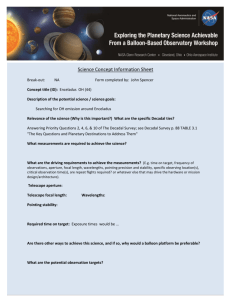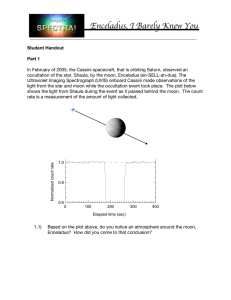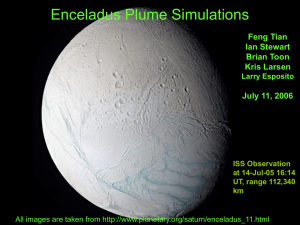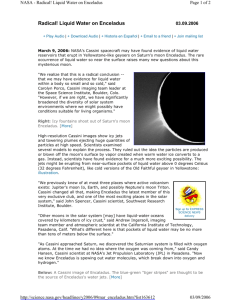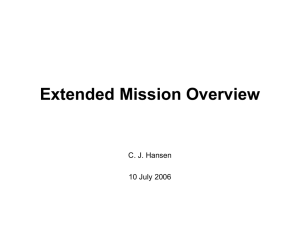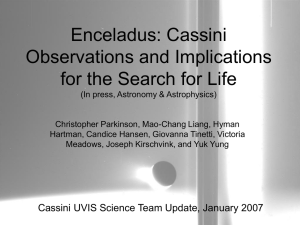Enceladus: Cassini Observations and Implications for the Search for Life
advertisement
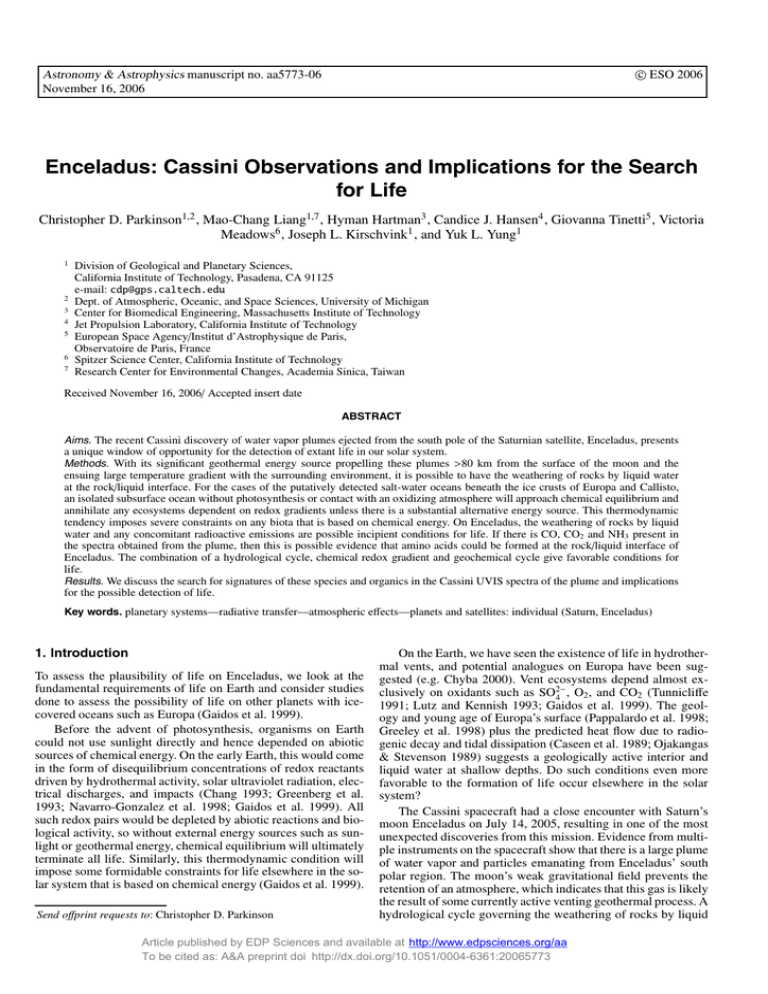
c ESO 2006 Astronomy & Astrophysics manuscript no. aa5773-06 November 16, 2006 Enceladus: Cassini Observations and Implications for the Search for Life Christopher D. Parkinson1,2 , Mao-Chang Liang1,7 , Hyman Hartman3 , Candice J. Hansen4 , Giovanna Tinetti5 , Victoria Meadows6 , Joseph L. Kirschvink1 , and Yuk L. Yung1 1 2 3 4 5 6 7 Division of Geological and Planetary Sciences, California Institute of Technology, Pasadena, CA 91125 e-mail: cdp@gps.caltech.edu Dept. of Atmospheric, Oceanic, and Space Sciences, University of Michigan Center for Biomedical Engineering, Massachusetts Institute of Technology Jet Propulsion Laboratory, California Institute of Technology European Space Agency/Institut d’Astrophysique de Paris, Observatoire de Paris, France Spitzer Science Center, California Institute of Technology Research Center for Environmental Changes, Academia Sinica, Taiwan Received November 16, 2006/ Accepted insert date ABSTRACT Aims. The recent Cassini discovery of water vapor plumes ejected from the south pole of the Saturnian satellite, Enceladus, presents a unique window of opportunity for the detection of extant life in our solar system. Methods. With its significant geothermal energy source propelling these plumes >80 km from the surface of the moon and the ensuing large temperature gradient with the surrounding environment, it is possible to have the weathering of rocks by liquid water at the rock/liquid interface. For the cases of the putatively detected salt-water oceans beneath the ice crusts of Europa and Callisto, an isolated subsurface ocean without photosynthesis or contact with an oxidizing atmosphere will approach chemical equilibrium and annihilate any ecosystems dependent on redox gradients unless there is a substantial alternative energy source. This thermodynamic tendency imposes severe constraints on any biota that is based on chemical energy. On Enceladus, the weathering of rocks by liquid water and any concomitant radioactive emissions are possible incipient conditions for life. If there is CO, CO2 and NH3 present in the spectra obtained from the plume, then this is possible evidence that amino acids could be formed at the rock/liquid interface of Enceladus. The combination of a hydrological cycle, chemical redox gradient and geochemical cycle give favorable conditions for life. Results. We discuss the search for signatures of these species and organics in the Cassini UVIS spectra of the plume and implications for the possible detection of life. Key words. planetary systems—radiative transfer—atmospheric effects—planets and satellites: individual (Saturn, Enceladus) 1. Introduction To assess the plausibility of life on Enceladus, we look at the fundamental requirements of life on Earth and consider studies done to assess the possibility of life on other planets with icecovered oceans such as Europa (Gaidos et al. 1999). Before the advent of photosynthesis, organisms on Earth could not use sunlight directly and hence depended on abiotic sources of chemical energy. On the early Earth, this would come in the form of disequilibrium concentrations of redox reactants driven by hydrothermal activity, solar ultraviolet radiation, electrical discharges, and impacts (Chang 1993; Greenberg et al. 1993; Navarro-Gonzalez et al. 1998; Gaidos et al. 1999). All such redox pairs would be depleted by abiotic reactions and biological activity, so without external energy sources such as sunlight or geothermal energy, chemical equilibrium will ultimately terminate all life. Similarly, this thermodynamic condition will impose some formidable constraints for life elsewhere in the solar system that is based on chemical energy (Gaidos et al. 1999). Send offprint requests to: Christopher D. Parkinson On the Earth, we have seen the existence of life in hydrothermal vents, and potential analogues on Europa have been suggested (e.g. Chyba 2000). Vent ecosystems depend almost exclusively on oxidants such as SO2− 4 , O2 , and CO2 (Tunnicliffe 1991; Lutz and Kennish 1993; Gaidos et al. 1999). The geology and young age of Europa’s surface (Pappalardo et al. 1998; Greeley et al. 1998) plus the predicted heat flow due to radiogenic decay and tidal dissipation (Caseen et al. 1989; Ojakangas & Stevenson 1989) suggests a geologically active interior and liquid water at shallow depths. Do such conditions even more favorable to the formation of life occur elsewhere in the solar system? The Cassini spacecraft had a close encounter with Saturn’s moon Enceladus on July 14, 2005, resulting in one of the most unexpected discoveries from this mission. Evidence from multiple instruments on the spacecraft show that there is a large plume of water vapor and particles emanating from Enceladus’ south polar region. The moon’s weak gravitational field prevents the retention of an atmosphere, which indicates that this gas is likely the result of some currently active venting geothermal process. A hydrological cycle governing the weathering of rocks by liquid Article published by EDP Sciences and available at http://www.edpsciences.org/aa To be cited as: A&A preprint doi http://dx.doi.org/10.1051/0004-6361:20065773 2 Christopher D. Parkinson et al.: Enceladus: Cassini Observations and Implications for the Search for Life water at the rock/liquid water interface and any concomitant radioactive emissions or other geothermal energy sources are possible incipient conditions for life (Hartman et al. 1993) and we discuss the evidence for this on Enceladus below. By hydrologic cycle, we mean processes that describe the constant movement of water above, on, and below Enceladus’ surface. During the hydrologic cycle, the water undergoes a continual change of state between liquid, solid and gas in four distinct processes. These processes are: (1) evaporation and venting, (2) precipitation, (3) infiltration and resurfacing, and (4) runoff. 2. CASSINI DATA AND ANALYSIS The Cassini UltraViolet Imaging Spectrograph (UVIS) observed the occultation of Bellatrix (γ-Orionis) as it passed behind Enceladus as seen from the spacecraft (Hansen et al. 2006). The UVIS high speed photometer recorded a decrease in signal intensity ∼24 seconds prior to occultation of the star by the hard limb, consistent with the presence of an atmosphere. The UVIS far ultraviolet (FUV) channel recorded absorption features as the starlight passed through the plume, with a column density of ∼1.5×1016 molecules cm−2 of water. This is the column density at 7 to 30 km above the surface along the line of sight of the spacecraft. Our analysis of the UVIS spectra for the presence of other molecules is carried out using the standard method of leastsquares linear regression (Bevington & Robinson 1992). The residual, obtained by subtracting the H2 O signal (Hansen et al. 2006) from the UVIS spectra, is shown in the upper panel in Figure 1. We then apply the linear regression to estimate upper limits for several molecules of astrobiological interest. We find that the signals from other species are within the noise fluctuation. The 1-σ upper limits of these molecules are given in Table 1. The normalized cross sections used in the above analysis are shown in the lower panel of Figure 1. Our calculated values for the upper limit of the column density of several species listed in Table 1 are consistent with detections from the other instruments aboard the Cassini spacecraft. The Ion and Neutral Mass Spectrometer (INMS) made measurements of the gaseous composition of the plume at altitudes of greater than 175 km and the Infrared Mapping Spectrometer (VIMS) determined that the surface of Enceladus is nearly pure ice water, with the exception of some organics and CO2 at the south pole, especially in the long, parallel crevasses dubbed “tiger strips”. The global temperature maps made by the Composite Infrared Spectrometer (CIRS) show that the “tiger stripes” are as much as 25 K warmer than the surrounding regions (Spencer et al. 2006). This is anomalously warmer than predictions from solar heating models, consistent with heat escaping from an internal heating source from this region (Burger et al. 2005). Matson et al. (2005) developed a thermal evolution model for Enceladus as a function of time of formation. Their models using radiogenic species and tidal dissipation can raise the core temperature in the vicinity of 1000 K. This allows for the presence of a liquid layer at the interface between the rocky core and an icy mantle, although, for some cases, venting liquid water vapor can obtain from lower temperatures (lower enthalpy) due to friction at the interface (Herkenhoff & Stevenson 1984; Raizer 1960). The Imaging Science Subsystem (ISS) observed a young surface and evidence of recent tectonic activity in the southern hemisphere (Johnson 2005; Helfenstein et al. 2005). Their estimates from cratering models place the age of the surface at less than 10-100 million years. The VIMS instrument saw that the ice in and around the “tiger stripes” is crystalline in nature, whereas it is amorphous elsewhere on the moon (Brown et al. 2005). The high degree of crystallinity seen in the coldest areas of the “tiger stripes” is consistent with fresh material, perhaps as young as a few decades. The albedo of a surface can be approximately described by R =1- (1-a)1/2, where a is the single scattering albedo of the scatterers. Comparing the surface of Dione that is not resurfaced and that of Enceladus which is resurfaced by the plumes, we can estimate a minimum flux of water from the plumes that remain on the surface. R = 0.55 for Dione implies a = 0.80. For Enceladus, R = 0.99 which implies a = 0.9999. The fraction of dark material to white material (ice) is 5×10−4 . Thus the flux of H2 O is about 2000 times that of meteoritic (dark) material. The micrometeoroid flux at Saturn is estimated to be 10−16 g cm−2 s−1 (Moses et al. 2000). (We assume all micrometeroids are trapped in the ice. In reality, only a fraction will be trapped. That fraction remains to be estimated in a later paper.) Therefore, the flux of water must exceed 2×10−13 g cm−2 s−1 , or ∼10−5 cm/yr. These extraterrestrial micrometeoroids will form a source of organic material for Enceladus. Subsequent resurfacing of the southern polar region due to plume material venting from the “tiger stripes” will eventually cause sinking of micrometeorite material down to the rock/ice interface (see Figure 2). We can estimate a higher resurfacing rate for Enceladus if we assume that a comparable mass of H2 O is retained as that lost in the plume, or ∼150 kg/s (Hansen et al. 2006). Averaged over the surface of the southern hemisphere of Enceladus, this is equivalent to 4×10−4 cm/yr. This value is consistent within a factor of a few as those given by Tian et al (2006). Also, for comparison, the erosion rate of the surface of Europa by ion sputtering has been estimated to be 2×10−5 cm/yr (Ip et al. 1998). The resurfacing rate of Europa must be on the order of or larger than this rate. Our calculations and review of the Cassini observations set the stage for understanding some of the mysterious processes surrounding the emanation of the plume from Enceladus. Within this context, we may begin a meaningful discussion of the implication of these results in the search for life. 3. ORIGIN OF LIFE Although the theory that life on Earth came from extraterrestrial sources (panspermia) cannot be excluded, it is not unreasonable to think that the first living systems on our planet are the result of a long chemical evolution that preceded biological evolution. What are the “ingredients” that induce incipient conditions for life? In the Introduction, we have highlighted the main requirements and we discuss these points in further detail below. Organic products can be obtained from submitting gas mixtures of various starting composition to electron or photon irradiation (Raulin 2005). When organics are produced, the formation occurs in the gas phase but also in the solid phase. The solid products are a prebiotic source of compounds of biological interest, such as amino acids and purine and pyrimidine bases. The primitive atmosphere of the Earth was probably not the starting point of the prebiotic organic processes, since its main compostion (CO2 -N2 -H2 O) was not favorable to the formation of organics. The main sources of organics are currently believed to be either from extraterrestrial influx (e.g., Chyba and Sagan 1992) or the synthesis of organic matter from inorganic molecules in the vicinity of submarine hydrothermal vents, as well as in shallow basins (Brack 1998; Raulin 2005). The VIMS data shows clearly a 3.4 µmE-ring absorption feature corresponding to organic compounds (Brown et al. 2005). Christopher D. Parkinson et al.: Enceladus: Cassini Observations and Implications for the Search for Life Rawlings et al. (2003) show that this feature can be explained by solid-phase aliphatic hydrocarbons, with possible substructure identified with symmetric and asymmetric CH stretching modes. A good fit to interstellar 3.4 µ profiles was obtained by Greenberg et al. (1995) using solar-photolysed mixtures of simple laboratory-prepared ices. Becker and Epstein (1982) showed that organic matter in carbonaceous chondrites can be separated into three fractions-1) a fraction insoluble in both methanol and chloroform, 2) a fraction soluble in chloroform and 3) a fraction soluble in methanol. Hartman et al. (1993) interpreted the first component, the fraction that is insoluble in chloroform and methanol, as of interstellar origin and the other two fractions chloroform-soluble hydrocarbons and methanol-soluble polar organics to have been synthesized on a hydrothermally altered planetoid body. The hydrocarbons (soluble in chloroform) were synthesized by a FischerTropsch mechanism on iron-rich clays on the planetoid body. The polar organic matter, i.e., amino acids, were synthesized close to the surface of the planetoid body by the radiolysis of hydrocarbons and ammonium carbonate in a liquid water environment on iron-rich clay surfaces. Ferrous ion acted as a protection against back reactions driven by radiolysis. The simultaneous synthesis of iron-rich clays with the polar organics may be indicative of events related to the origin of life on Earth. Such a scenario may also be plausible on Enceladus. Gaidos et al. (1999) claim that nearly all metabolic life-styles on the present Earth would not be possible for organisms inhabiting an ice-covered ocean on Europa because the flux of soluble oxidants produced or transported into the water column is too low. Geochemical energy could power a relatively feeble ecology but requires volcanic resurfacing or plate tectonics. For Enceladus, it appears that we have the necessary hydrological cycle as well as geologically active, energy-generating reactions sufficient to create a redox gradient favorable for life (see Figure 2), as well as the possibility of peroxide-laden ice from the Ering of Saturn re-accreting to the surface. The most abundant oxidant on icy satellites is most likely H2 O2 , which has been detected on Europa (Carlson et al. 1999), with a volume mixing ratio as high as 0.13%. We can make a rough estimate of the rate of production of H2 O2 by analogy with that on Europa, where the production rate by sputtering is estimated to be 2×1011 molecules cm−2 s−1 , based on the energy flux of charged particles (see Carlson et al. 1999 and Table 2 for details). Since the full energy spectra of charged particles in the Saturnian magnetosphere have not been derived, we assume that the ratio of the H2 O2 production rate and the H2 O sputtering rate is the same for Europa and Enceladus. The sputtered H2 O flux is 1.4×109 molecules cm−2 s−1 for Europa (Shi et al. 1995; Cooper et al. 2001). On Enceladus, the H2 O sputtering flux (Jurac et al. 2002; Richardson and Jurac 2004) is ∼109 molecules cm−2 s−1 , implying that the production rate of H2 O2 at Enceladus would be of the same magnitude as that on Europa ≈ 1011 molecules cm−2 s−1 . R. Battaglia (private communication) suggested to the authors that this value may be as much as one to two orders of magnitude too high. On Enceladus, however, there is a more active hydrological cycle transporting the oxidants down to the rock/water interface (see Figure 2). In addition, the weathering of rocks by liquid water at the rock/liquid interface and any concomitant radioactive emissions (that some authors have proposed) are possible incipient conditions for life (Hartman et al. 1993). Hydrothermal alteration and weathering could drive the equilibration of a liquid water and silicate crust chemistry (Gaidos et al. 1999). As we just discussed, some H2 O2 is being produced in the surface ice of Enceladus. Additionally, we can introduce the 3 notion of Saturn’s E-ring as a “chemical processor” to provide additional H2 O2 . We know that water is being ejected from Enceladus in sufficient quantities to keep this ring in existence and fairly stable over time (Hansen et al, 2006). This frozen water in the ring will be exposed to energetic particles and UV irradiance over time and some of the water will be converted to H2 O2 which can be picked up again by the moon as it sweeps through the ring while it is moving it its orbit. In this manner, the E-ring can be seen as acting as an extended “surface” providing a new oxidant source for Enceladus. The presence of organics and the probable presence of clay minerals alongside an ample (and possibly huge) source of oxidants on Enceladus make it a plausible venue for the origin life, as has been suggested for similar system on Earth (Russell et al. 2002). On the other hand, terrestrial life uses a chemistry dependent upon DNA and RNA, and the chemical synthesis of a critical component of this - the 5 carbon sugar, ribose - has only been stabilized in the presence of Calcium Borate minerals that are highly soluble in water (Ricardo et al. 2004). Unless another as-yet undiscovered abiotic pathway exists for ribose synthesis, life on Enceladus would most likely have a fundamentally different chemistry than that on Earth. Panspermia, the transfer of life through space on meteorites (e.g., Kirschvink et al. 2002) is essentially impossible because of the high impact velocity of particles falling into Saturn’s high gravitational well, and the lack of an atmosphere to decelerate them without sterilizing the interior. The habitability and detection questions will be addressed in the following section. 4. HABITABILITY AND DETECTION We have seen from analysis of the spectra obtained from the plume during the Cassini flyby of Enceladus that many required species such as CO, CO2 and NH3 may be present (see Table 1), and that there is possible evidence that amino acids could be formed at the rock/liquid interface of Enceladus, where clay formations should exist due to rock weathering from liquid water or from micrometeorite accumulation due to resurfacing. Power is not a problem since resonance with Dione forces tidal heating and there is radiogenic heating as well. It is possible there is additional heating due to differentation of the moon body with a molten core (Matson et al. 2005). Gaining insight into the origin, evolution and distribution, as well as the future of life on Earth and elsewhere in the solar system and the universe, is the primary mission of astrobiology. The combination of a hydrological cycle, chemical redox gradient and geochemical cycle give favorable conditions for life on Enceladus. To our knowledge, these conditions are not duplicated anywhere else in our solar system except our planet. Compared to Mars, Titan and Europa, Enceledus is the only other object in our solar system that appears to satisfy the conditions for maintaining life at present, even if the ability of life to evolve there is uncertain. Mars may have had a hydrological cycle in its early history, but there is no evidence that one exists today. Titan may be a repository of pre-biotic organic chemicals, but the conditions do not appear favorable for the development of life. Europa currently may have a hydrological cycle, but it may be a closed chemical system that will eliminate any chemical redox gradient in a geologically short time. Presently Enceladus is the most exciting object in the solar system for the search of extant life. We have compelling evidence supporting the view that Enceladus has active hydrological, chemical and geochemical cycles, which are essential ingredients for originating and sustaining life. Planetary protection issues aside, if life does not 4 Christopher D. Parkinson et al.: Enceladus: Cassini Observations and Implications for the Search for Life yet exist on Enceladus, artificial introduction of terrestrial life to this environment would be an interesting, and most likely successful experiment. Future ground based and space observations and future space missions are needed to advance our understanding of Enceladus. These include (1) long-term observations to establish whether the plumes are transient or in steady-state, (2) searching for molecules of astrobiological significance, such as NH3 , (3) searching for the presence of photopigments (e.g. chlorophyll), (5) identifying the presence of oxidants on the surface, such as H2 O2 , and (6) mapping the North-South gradient in surface properties to quantify the rate of impact erosion and resurfacing (Baratta et al. 1991). Laboratory studies are needed, (1) to identify the chemical species responsible for 3.4 m absorption feature in the ice in the “tiger stripes” (Berstein et al. 2005), (2) to study the chemical evolution of organics in ice in the presence of energetic photons and particles, and (3) to quantify the rate of production of oxidants such as H2 O2 for conditions appropriate for Enceladus. Finally, modeling studies are needed to link the observations and laboratory experiments to the evolution of the hydrological, chemical redox and geochemical cycles on Encaladus. Acknowledgements. We thank Xun Jiang for assistance with linear regression, Andy Ingersoll, G. Orzechowska, and David Stevenson for helpful discussions. We thank F. Tian for communication of results prior to publication. We thank R. West for helpful comments and D. Shemansky for sharing the photoabsorption cross-sections of HCN. This work was supported by NASA grant NASA513296 to California Institute of Technology. The research at the Jet Propulsion Laboratory (JPL), California Institute of Technology, was performed under contract with the National Aeronautics and Space Administration. References Becker, R. H. and Epstein, S., Geochimica et Cosmochimica Acta, 46, 97-103, 1982. Bevington, P. R. & Robinson, D. K. 1992, (WCB/McGraw-Hill, Second Edition) Brack, A., 1999, Advances in Space Research, 24, Issue 4, p. 417-433. Brown, R. H., and colleagues, 2006, Science, 311, 1425–1428. Burger, M. H., Sittler, E. C., Johnson, R. E., Shematovich, V. I., and Tokar, R. L., American Geophysical Union, Fall Meeting 2005, abstract P32A-08. Carlson, R. W., and colleagues. 1999, Science, 283, 2062. Cassen, P. M., Reynolds, R. T., and Peale, S. J., Geophys. Res. Lett., 6, 731, 1979. Chang, S., in The Chemistry of Life’s Origins, J. M. Greenberg et al., Eds., 1993, (Kluwer Academic, Boston), pp. 259-299, Cheng, B.-M, Lu, H.-C., Chen, H.-K., Bahou, M., Lee, Y.-P., Mebel, A. M., Liang, M.-C., & Yung, Y. L. 2006, ApJ, in press. Chyba, C., 2000, Nature, 403, 381–382. Chyba, C. and Sagan C., 1992, Nature, 355, 125–132. Cooper, J. F., Johnson, R. E., Mauk, B. H., Garrett, H. B., and Gehrels, N. 2001, Icarus, 149, 133. Davies, A. G. 1996, Icarus, 124, 45 Gaidos, E. J., Nealson, K. H., Kirschvink, J. L. 1999, Science, 284, 1631. Greeley, R., et al. 1998, Icarus, 135, 4. Hansen, C. J., Esposito, L., Stewart, A.I.F., Colwell, J., Hendrix, A., Pryor, W., Shemansky, D., West, R. 2006, submitted Science. Hartman, H., Sweeney, M. A., Kropp, M.A., Lewis, J. S. 1993, Origin of Life and Evolution of the Biosphere, 23, 221. Helfenstein, P., Thomas, P. C. Ververka, J., Squyers, S., Rathburn, J. A., Denk, T., Neukum, G., Rastsch, T., Wagner, R., Perry, J., Turtle, E., McEwan, A.S., Johnson, T. 2005, B.A.A.S., 37, 21 Herkenhoff, K. E., and Stevenson, D. J., B.A.A.S., 1984. Johnson, T. V., Porco, C. 2005, B.A.A.S., 37, 36.01. Jurac, S., McGrath, M. A., Johnson, R. E., Richardson, J. D., Vasyliunas, V. M., and Eviatar, A. 2002, Geophys. Res. Lett., 29, 2172. Kirschvink, J.L., & Weiss, B.P. 2002 Mars, Panspermia, and the Origin of Life: Where did it all begin? Palaeontologia Electronica v.4 (2) 8-15. http://palaeo-electronica.org/paleo/2001 2/editor/mars.htm Lee, A. Y. T., Yung, Y. L., Cheng, B. M., Bahou, M., Chung, C. Y., & Lee, Y. P. 2001, ApJ, 551, L93. Lee, L. C. 1980, Journal of Chemical Physics, 72, 6414. Lutz, R. A., and Kennish, M. J. 1993, Rev. Geophys., 31, 211. Matson, D. L., Castillo, J. C., Johnson, T. V., Lunine, J. I., McCord, T. B., Sotin, C., Thomas, P. C., Turtle, E. P. 2005, B.A.A.S., 37, 32-A.05. Moses, J. I., Lellouch, E., Bezard, B., Gladstone, G. R., Feuchtgruber, H., & Allen, M. 2000, Icarus, 145, 166 Nagata, T., Kondow, T., Ozaki, Y., & Kuchitsu, K. 1981, Chemical Physics, 57, 45 Navarro-Gonzalez, R., Molina, M. J., Molina, L. T. 1998, Geophys. Res. Lett., 25, 3123. Nuth, J. A., & Glicker, S. 1982, Journal of Quantitative Spectroscopy & Radiative Transfer, 28, 223 Ojakangas, G. W., and Stevenson, D. J. 1989, Icarus, 81, 220. Pappalardo, R. T., et al. 1998, Nature, 391, 365. Raizer, Y. P. 1960, Soviet Physics JETP, 37, 1229. Raulin, F., 2005, Space Science Reviews, 116, Issue 1-2, 471-487. Rawlings, J., 2003, Ap&SS, 285, Issue 3, p. 777-789. Richardson, J. D., and Jurac, S. 2004, Geophysical Research Letters, 31, 24803. Ross, M. N., and Schubert, G. 1987, Nature, 325, 133. Rufus, J., Stark, G., Smith, P. L., Pickering, J. C., & Thorne, A. P. 2003, Journal of Geophysical Research-Planets, 108. Russell, M.J. and Hall, A.J. 2002, From Geochemistry to Biochemistry: Chemiosmotic coupling and transition element clusters in the onset of life and photosynthesis. The Geochemical News, 113, 6-12. Ricardo, A., M. A. Carrigan, et al. 2004 ”Borate Minerals Stabilize Ribose.” Science 303(5655), 196-196. Shi, M., Baragiola, R. A., Grosjean, D. E., Johnson, R. E., Jurac, S., and Schou, J. 1995, Journal of Geophysical Research-Planets, 100, 26387. Smith, P. L., Yoshino, K., Parkinson, W. H., Ito, K., Stark, G. 1991, Journal of Geophysical Research, 96, 17529. Spahn et al., 2006, Science, 311, 1416. Squyres, S. W., et al. 1983, Nature, 301, 225. Tian et al., 2006, submitted Icarus. Tokar et al., 2006, Science, 311, 1409. Tunnicliffe, V. 1991, Oceanogr. Mar. Biol., 29, 319. Yoshino, K., Esmond, J. R., Sun, Y., Parkinson, W. H., Ito, K., & Matsui, T. 1996, J. Quant. Spectrosc. Radiat. Transfer, 55, 53. Yoshino, K., Freeman, D. E., Esmond, J. R., & Parkinson, W. H. 1987, Planetary Space Science, 35, 1067. Christopher D. Parkinson et al.: Enceladus: Cassini Observations and Implications for the Search for Life Table 1. Detected species and upper bound for molecules of astrobiological interest. Molecules Column Densitya Referencesb N2 H2 O CO CO2 O2 CH4 C 2 H2 C 2 H6 HCN 0.040 1.5 × 1016 < 1.3 × 1014 < 1.8 × 1017 < 2.5 × 1018 < 5.6 × 1015 < 1.6 × 1015 < 4.0 × 1015 < 2.7 × 1015 NH3 SO2 < 1.3 × 1016 < 2.2 × 1015 dust electron N+ Organics CO2 a b ∼ 0.1m−3 ∼ 100cm−3 ∼ 3% of total ion Detected in ice Detected in ice Waite et al. (2006) Hansen et al. (2006) Hansen et al. (2006) this work, Yoshino et al. (1996) this work, Yoshino et al. (1987) this work, Lee et al. (2001) this work, Smith et al. (1991) this work, Lee et al. (2001) this work, Lee (1980) Nagata et al. (1981) Nuth & Glicker (1982) this work, Cheng et al. (2006) this work, Rufus et al. (2003) Spahn et al. (2006) Tokar et al. (2006) Bouhram et al. (2006) Brown et al. (2006) Brown et al. (2006) 1-σ upper limit for which column density is not constrained (units in molecules cm−2 ) References for laboratory measured photoabsorption cross sections. Values for H2 O and CO are the results derived by Hansen et al. (2006). Table 2. UV and Energetic Particle fluxes at Enceladus. Values are taken and scaled from Madey, Johnson, and Orlando (2002) Radiation Flux (cm−2 s−1 ) Energy flux (eV cm−2 s−1 ) Solar photons IR (<1.8 eV) Visible (1.8-3.1 eV) UV-A (3.1-3.9 eV) UV-B (3.9-4.4 eV) UV-C (4.4-12.4 eV) EUV (>12.4 eV) Lyman-α 2.2 × 1015 1.1 × 1015 2.2 × 1014 2.7 × 1013 1.1 × 1012 1.1 × 108 3.3 × 109 9.3 × 1015 4.4 × 1015 4.1 × 1015 7.9 × 1014 1.1 × 1014 4.7 × 1013 1.4 × 109 3.3 × 1010 Solar wind 1 keV/u H+(96%), He++(4%) electrons ( ∼12 eV) 4.4 × 106 4.4 × 106 4.4 × 109 5 × 107 2 6 × 109 4 × 1012 1 × 1013 Cosmic ray ions Magnetospheric plasmas 5 6 Christopher D. Parkinson et al.: Enceladus: Cassini Observations and Implications for the Search for Life Fig. 1. Upper panel: the ratio of occulted and unocculted Bellatrix’s spectra after H2 O vapor has been removed. Lower panel: the normalized cross section (from 0 to 1) of all molecules we have upper limits for in Table 1. Christopher D. Parkinson et al.: Enceladus: Cassini Observations and Implications for the Search for Life Fig. 2. Schematic illustration the hydrological, geochemical and chemical redox cycles on Enceladus. 7
